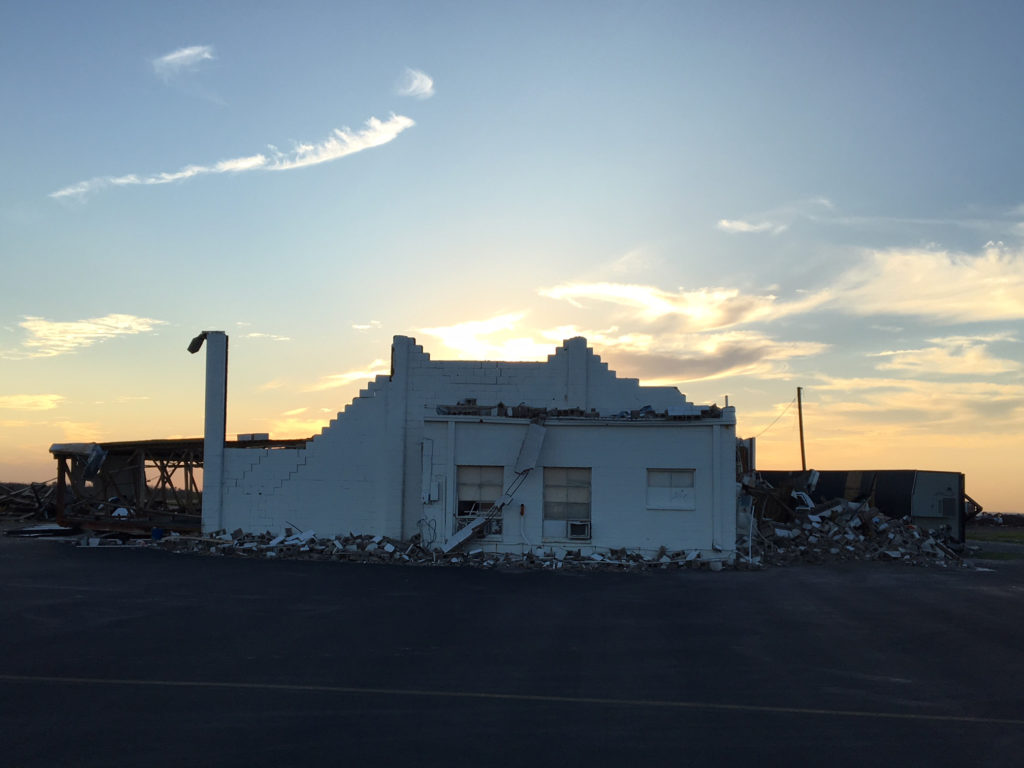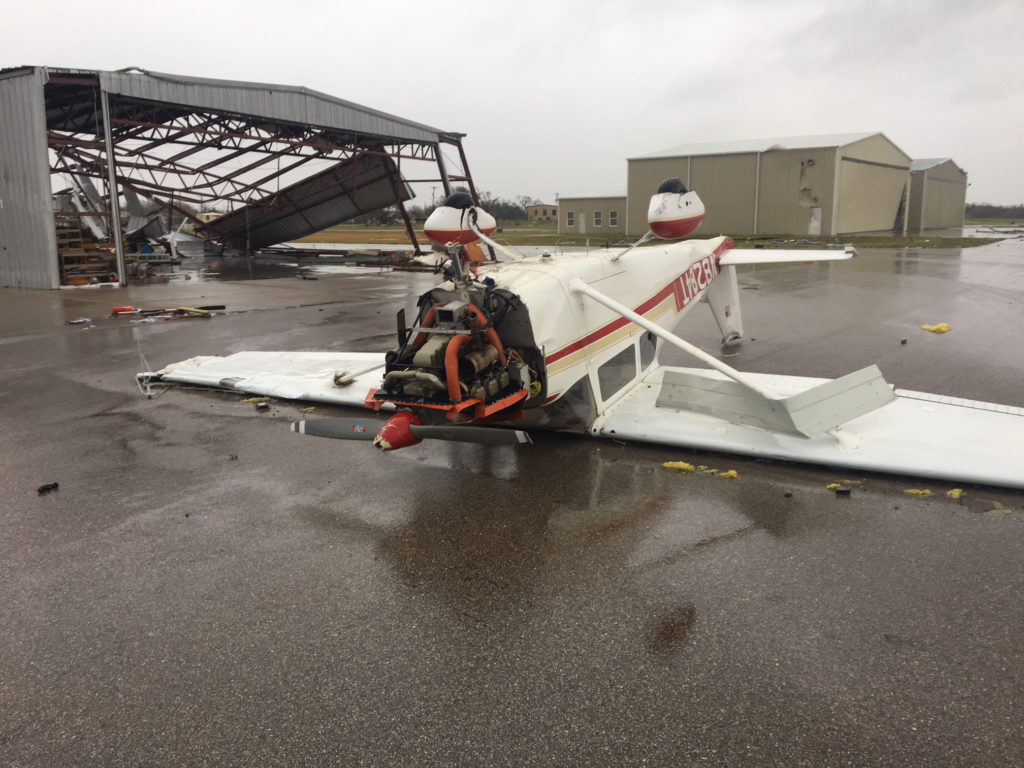By Chris Sasser
Texas A&M Transportation Institute

An aerial view of the Aransas County Airport terminal building (red roof) and the destroyed cinder block hangar, originally built in 1943. Vehicles were parked inside the hangar to protect them from Hurricane Harvey.
August 25, 2017, is a day that Rockport, Texas, residents will never forget. It was the day Hurricane Harvey, a Category 4 hurricane, made landfall at peak intensity at Rockport with winds of 130 mph, becoming the first major hurricane to make landfall in the United States since Wilma in 2005.
A day earlier, Aransas County Airport (KRKP) manager and Air Force veteran Mike Geer studied the gathering storm clouds as he prepared to ride out the hurricane in the terminal building. A native of the Dallas area, Geer had spent summers vacationing in Rockport while growing up, but nothing could prepare him for what was to come.
“Harvey lulled us to sleep a little bit,” explained Geer. “We weren’t sure how strong it was going to be or where it was going to make landfall. By the time it intensified to the point where it was a major hurricane with the potential for a lot of destruction, it was too late.”
Rockport is a tourist destination, and the majority of the hangar tenants at the airport were from out of town, making it a priority for Geer and his staff to visit every building to ensure everything was prepared for the storm.
“We were limited on staff, so things like installing the storm windows on the terminal building took two employees a full day,” noted Geer. “We tried to secure a few portable buildings, but there was no chance for them to make it. Those were hours wasted. We just didn’t know, though; it was such a powerful storm.”
Among the damaged buildings included an original 1943 airport hangar that collapsed at 9 p.m., and the storm did not officially arrive until 11 p.m.
Geer, a member of his staff, and a few family members spent hours huddled in the terminal building waiting out the massive storm.
“The last reading I saw on our ASOS (Automated Surface Observing System) was 143 mph with gusts of 160 mph before we lost it,” noted Geer. “The building took the north wind pretty well, but when the eye passed and the winds shifted to the south, you could see the southern wall flex in and out. That’s when we went to our ‘hunker down’ spot to a storage room in the center of the building.”
The hurricane lasted all night. When it was over, Geer went outside to assess the damage.
“We woke up at 7 a.m. and were checked on by several local officials,” said Geer. “Then everything came naturally. We knew we had to have a place where helicopters could safely land. Then we had to make our fuel system operational.”
A few days after the storm struck, Matthew Heinze with the Texas Department of Transportation arrived with a crew to assist in the cleanup (see accompanying story on p. 8). With Heinze and his crews’ assistance, they worked to clear the runways and taxiways of storm debris. Runway 18-36 was used for emergency response vehicles, while 14-32 reopened for fixed-wing use.
“It was all part of the plan we had in place,” explained Geer. “We knew this was going to be an active hurricane season, so we planned that we could use our ‘spare pavement’ and land for the first responders to use. At one time we had over 1,200 people, which included emergency responders and utility workers, living at the airport.”
In all, seven total structures were destroyed. An entire plane was lost that was later found mangled against a game fence on the other side of the airport. The airport also lost almost half of its T-hangar customers because the hangars or planes were no longer usable.
Geer was proud to have the airport as a staging area in the aftermath of the storm for the citizens of his community.
“It’s the highest ground in the county,” said Geer. “We did exactly what I wanted our airport to do during the days and months after the hurricane.”
For Geer, who already had big shoes to fill taking over for long-time airport manager Gene Johnson in 2014, rebuilding the airport after this unprecedented disaster presents the challenge of his career.
“I’ve thought about this many times, and what if I had just one more day or even a few more hours, what would I have done?” said Geer. “I think that’s the biggest lesson learned. I’ll take action a lot sooner and in a lot more meaningful ways. We’re going to learn from this event and move forward to have a better, stronger airport.”



